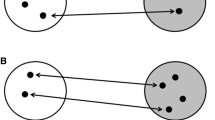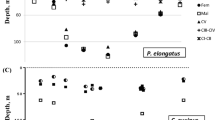Abstract
Although evolutionary ecologists agree that proximate and ultimate aspects are two sides of one coin, they are seldom interested in studies on physiological and behavioural mechanisms at the base of ecological phenomena. Nevertheless, these mechanisms are objects of selection and evolved to realise adaptive significances. This paper is a plea to bring both fields closer together, and, by means of an example of Diel Vertical Migration of Daphnia, some proximate and ultimate aspects are discussed. It is argued that light changes, not fish kairomone, is the primary cause for an individual to swim downwards at dawn and upwards at dusk. However, what is called a causal factor might differ when ecosystems or individuals are studied. In addition, causality in ecology is not simple, and has the character of a `set of necessary conditions'. To illustrate the importance of proximate analyses in DVM, two basic response mechanisms are discussed: Photobehaviour system 1 and 2. The physiological character of these systems leads to a fixed type of migration or to a phenotypically induced DVM, respectively. The adaptive significance of the first might be a reduction of the hazardous effects of UV radiation and of the second a lowering of mortality due to visually hunting predators.
Similar content being viewed by others
References
Alcock, J., 1989. Animal Behavior. Sinauer Associates, Inc., Sunderland: 1-596.
Bollens, S. M., B. W. Frost & J. R. Cordell, 1994. Chemical, mechanical and visual cues in the vertical migration behavior of the marine planktonic copepod Acartia hudsonica. J. Plankton Res. 16: 555-564.
Bottrell, H. H., A. Duncan, Z. M. Gliwicz, E. Grygierek & A. Herzig, 1976. A review of some problems in zooplankton production studies. Norw. J. Zool. 24: 419-456.
Clarke, G. L. 1932. Quantitative aspects of the change in phototropic signs in Daphnia. J. Exp. Biol. 9: 180-211.
Dawidowicz, P. & C. J. Loose, 1992. Metabolic costs during predator-induced diel vertical migration of Daphnia. Limnol. Oceanogr. 37: 1589-1595.
Dawidowicz, P., J. Pijanowska & K. Ciechomski, 1990. Vertical migration of Chaoborus larvae is induced by the presence of fish. Limnol. Oceanogr. 35: 1631-1637.
de Meester, L. & L. J. Weider, 1999. Depth selection behavior, fish kairomones, and the life histories of Daphnia hyalina ×galeata hybrid clones. Limnol. Oceanogr. 44: 1248-1258.
Dini, M. L., P. A. Soranno, M. Scheuerell & S. R. Carpenter, 1993. Effects of predators and food supply on diel vertical migration of Daphnia. In Carpenter, S. R. & J. F. Kitchell (eds), The Trophic Cascade in Lakes. New York: 153-171.
Dodson, S. I., 1988. The ecological role of chemical stimuli for the zooplankton: predator-avoidance behavior in Daphnia. Limnol. Oceanogr. 33: 1431-1439.
Fiksen, O., 1997. Allocation patterns and diel vertical migration: modeling the optimal Daphnia. Ecology 78: 1446-1456.
Forward, R. B., 1993. Photoresponses during diel vertical migration of brine shrimp larvae: effect of predator exposure. Arch. Hydrobiol. Beih. Ergebn. Limnol. 39: 37-44.
Haney, J. F., 1993. Environmental control of diel vertical migration behaviour. Arch. Hydrobiol. Beih. Ergebn. Limnol. 39: 1-17.
Iwasa, Y., 1982. Vertical migration of zooplankton: a game between predator and prey. Am. Nat. 120: 171-180.
Krebs, C. J., 1972. Ecology. Harper & Row, New York: 1-694.
Krebs, J. R. & N. B. Davies 1993. An Introduction to Behavioural Ecology. Blackwell, Science, Oxford: 1-420.
Lima, S. L., 1998. Stress and decision making under the risk of predation: recent developments from behavioral, reproductive, and ecological perspectives. Adv. Stud. Beh. 27: 215-290.
Loose, C. J., 1993. Lack of endogenous rhythmicity in Daphnia diel vertical migration. Limnol. Oceanogr. 38: 1837-1841.
Loose, C. J. & P. Dawidowicz, 1994. Trade-offs in diel vertical migration by zooplankton: The costs of predator avoidance. Ecology 75: 2255-2263.
Neill, W. E., 1990. Induced vertical migration in copepods as a defence against invertebrate predation. Nature 345: 524-525.
Reede, T. & J. Ringelberg, 1998. Differential life history responses of several pelagic Daphnia clones differing in migratory behaviour. Aquat. Ecol. 32: 245-253.
Rhode, S. C., M. Pawlowski & R. Tollrian, 2001. The impact of ultraviolet radiation on the vertical distribution of zooplankton of the genus Daphnia. Nature 412: 69-72.
Ringelberg, J., 1991. Enhancement of the phototactic reaction in Daphnia hyalina by a chemical mediated by juvenile perch (Perca-fluviatilis). J. Plankton Res. 13: 17-25.
Ringelberg, J., 1999a. The photobehaviour of Daphnia spp. as a model to explain diel vertical migration in zooplankton. Biol. Rev. Camb. Phil. Soc. 74: 397-423.
Ringelberg, J., 1999b. The role of infochemicals in lake plankton crustacean behavior and predator-prey relations. In von Vaupel Klein, J. C. & F. R. Schram (eds), The Biodiversity Crisis and Crustacea. Proc. 4th crustacean congress, Amsterdam 1998. A.A. Balkema, Rotterdam: 161-175.
Ringelberg, J. & B. J. G. Flik, 1984. The mortality effect of ultraviolet radiation in a translucent and in a red morph of Acanthodiaptomus denticornis (Crustacea, Copepoda) and its possible ecological relevance. Hydrobiologia 112: 217-222.
Ringelberg, J. & B. J. G. Flik, 1994. Increased phototaxis in the field leads to enhanced diel vertical migration. Limnol. Oceanogr. 39: 1855-1864.
Ringelberg, J., B. L. G. Flik, D. Lindenaar & K. Royackers, 1991. Diel vertical migration of Daphnia hyalina (sensu latiori) in Lake Maarsseveen: Part: 1. Aspects of seasonal and daily timing. Arch. Hydrobiol. 121: 129-145.
Ruse, M., 1973. The Philosophy of Biology. Hutchinson University Library, London: 1-232.
Siebeck, O., T. L. Vail, C. E. Williamson, R. Vetter, D. Hessen, H. Zagarese, E. Little, E. Balseiro, B. Modenutti, J. Seva, & A. Shumate, 1994. Impact of UV-B radiation on zooplankton and fish in pelagic freshwater ecosystems. Arch. Hydrobiol. Beih. Ergebn. Limnol. 43: 101-114.
Spaak, P. & J. Ringelberg, 1997. Differential behaviour and shifts in genotype composition during the beginning of a seasonal period of diel vertical migration. Hydrobiologia 360: 177-185.
Stirling, G. & D. A. Roff, 2000. Behaviour plasticity without learning: phenotypic and genetic variation of naive Daphnia in an ecological trade-off. Anim. Behav. 59: 929-941.
van Gool, E., 1998. Diel vertical migration of Daphnia: an inquiry into mechanisms of phototactic behaviour. Ph.D. Thesis, University of Amsterdam, Amsterdam, 117 pp.
van Gool, E. & J. Ringelberg, 1997. The effect of accelerations in light increase on the phototactic downward swimming of Daphnia and the relevance to diel vertical migration. J. Plankton Res. 19: 2041-2050.
van Gool, E. & J. Ringelberg, 1998. Light-induced migration behaviour of Daphnia modified by food and predator kairomones. Anim. Behav. 3: 741-747.
van Gool, E. & J. Ringelberg, 2002. When to migrate: the mechanism of a daily habitat shift. Hydrobiologia (this volume).
Author information
Authors and Affiliations
Rights and permissions
About this article
Cite this article
Ringelberg, J., Van Gool, E. On the combined analysis of proximate and ultimate aspects in diel vertical migration (DVM) research. Hydrobiologia 491, 85–90 (2003). https://doi.org/10.1023/A:1024407021957
Issue Date:
DOI: https://doi.org/10.1023/A:1024407021957




